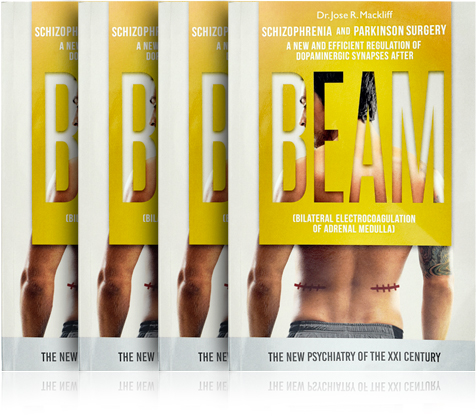The case of Sergio (April 2012)
Age: 21 yrs. Lives in Mexicale, Baja California. A patient with 7 years of schizophrenia. He's been institutionalized in 5 different occasions (two-three months) due to severe aggressiveness episodes.
Symptoms:
High level of apathy and lack of motivation (past 4 years)
For the past year he defecates and urinates in diaper
During 18 months he doesn't speak to relatives, he just screams and walks in the nude in the house
His encephalogram revealed a brain disrythmia.
Sergio's medication before the surgery was: Clozapine-valproato. Topiramato-risperidone. Without any changes in the symptomatology for years.
April 3rd,2012 – first consultation in Guayaquil, Ecuador
Sergio couldn't answer any question, his head was low, looking at the floor. Few minutes after the appointment started, he kicked the desk – interrupting the examination.
On April 6th, 2012, he underwent B.E.A.M procedure
Two days after surgery (April 8th) the patient started to talk to the Dr. and his own relatives – engaging in conversation -, asked to go to the bathroom, and was able to defecate and urinate by himself. The family and relatives expressed their amazement with his 48 hour recovery
At the present time, Sergio lives with his family. He is constantly displaying his good mood, helps his mother at home, runs errands, and accompanies her. . His actual treatment: Clozapine 200mg and Sodic valproate 200mg – in lesser dosage than pre-BEAM
In all of the schizophrenia cases, immediately after the surgery a recovery of the deficitarian symptoms is evident; sociability is notably improved and 8 days after surgery, relatives can observe the difference in conduct and adaptability, characteristics that the patient was lacking. Overall it is after 3 to 4 months when the recovery is compelling. These changes can only be obtained with the surgery.
Among the most common questions that families and physicians have is whether this surgery can make a person develop Addison's disease. Addison originates when the adrenal cortex tissue is damaged. B.E.A.M. does not go that far, it only works on the adrenal medulla, thus leaving the kidney untouched. People are often concerned also, on whether the patient will remain "slow"(no alertness) since adrenaline is diminished. The surgery does block the main source of adrenaline, but it is generated in lesser amounts by other alternate means in our system, adrenaline is replaced by noradrenaline and cortisol, where the brain/hypothalamus will take on the producer role, since the suprarenal no longer creates it. B.E.A.M is a surgery of a regulatory nature. Since 2.006, up until now, none of the cases treated, show collateral side-effects.
Another concern is that If the patient will need Cortisol to be administered after B.E.A.M. in a frequent manner. B.E.A.M. does not touch the adrenal cortex, where cortisol is produced; it only reaches for the adrenal marrow. With all the cases that underwent B.E.A.M., and the actual experience that is now re-writing medicine, there is now hard evidence in regards to the safety of this surgery and its benefits.
RETURN TO RESULTS
|




